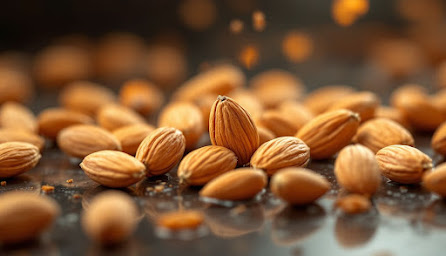The 5 Best High-Fiber Foods for Diabetes, According to a Dietitian
As a dietitian, I often get asked about the best foods for managing diabetes. While there are many factors to consider, one of the most important is fiber intake. High-fiber foods can help regulate blood sugar levels, improve insulin sensitivity, and even support weight loss.
For those looking for an effective way to manage blood sugar naturally, diet plays a crucial role. In this article, we'll explore the top 5 high-fiber foods for diabetes, along with some tips for incorporating them into your daily routine.
What is Fiber and Why is it Important for Diabetes?
Fiber is a type of carbohydrate that is not easily broken down by the body. It's found in plant-based foods like fruits, vegetables, whole grains, and legumes. There are two types of fiber: soluble and insoluble. Soluble fiber dissolves in water and forms a gel-like substance in the digestive system, while insoluble fiber does not dissolve in water and helps add bulk to stool.
A high-fiber diet is important for diabetes management because it can slow down the absorption of sugar into the bloodstream. This helps regulate blood sugar levels and improves insulin sensitivity. Additionally, high-fiber foods tend to be more filling and can aid in weight management, which is also crucial for controlling diabetes.
The Top 5 High-Fiber Foods for Diabetes
Here are the top 5 high-fiber foods for diabetes, their benefits, and tips on how to include them in your diet.
🥑 Avocados: 1 medium avocado contains 10 grams of fiber
Avocados are an excellent source of soluble fiber, which slows sugar absorption into the bloodstream. They're also rich in healthy fats that can support weight loss and improve insulin sensitivity.
How to eat: Add sliced avocado to omelets, blend it into smoothies, or use it as a creamy topping for salads.
🥣 Legumes: 1 cup cooked legumes contains 15-16 grams of fiber
Legumes, including lentils, chickpeas, black beans, and kidney beans, are high in fiber and low in fat. They also provide complex carbohydrates, which help regulate blood sugar levels.
How to eat: Try adding fiber-rich legumes to soups, stews, or salads for a delicious and nutritious boost.
🍝 Whole Wheat Spaghetti: 1 cup cooked whole wheat spaghetti contains 6 grams of fiber
Whole wheat spaghetti is a great source of insoluble fiber, which helps with digestion and keeps you feeling full longer. The complex carbs in whole grains also play a role in blood sugar regulation.
How to eat: Pair it with a low-sugar tomato sauce and sautéed vegetables for a healthy, balanced meal.
🥦 Brussels Sprouts: 1 cup cooked Brussels sprouts contains 5 grams of fiber
Brussels sprouts are a powerhouse of fiber, vitamins, and minerals. They are packed with blood sugar-friendly nutrients like vitamin C and potassium, making them a fantastic choice for diabetics.
How to eat: Roast them in the oven with olive oil and sea salt for a delicious side dish.
🥜 Almonds: 1 ounce almonds contains 3.5 grams of fiber
Almonds are loaded with fiber, protein, and healthy fats. They support weight loss and provide a slow-releasing source of energy, which helps stabilize blood sugar levels.
How to eat: Snack on fiber-rich almonds throughout the day, or add them to oatmeal or yogurt for a satisfying crunch.
Tips for Incorporating High-Fiber Foods into Your Diet
Here are some practical ways to increase your fiber intake and support healthy blood sugar levels:
✔ Start slow: If you're not used to eating high-fiber foods, add them gradually to avoid digestive discomfort.
✔ Include variety: Consume a mix of fruits, vegetables, whole grains, and legumes to maximize the benefits.
✔ Drink more water: Fiber absorbs water, so staying hydrated prevents constipation and supports digestion.
✔ Watch portion sizes: While fiber is essential, be mindful of calories when incorporating fiber-rich foods into your diet.
Conclusion
A fiber-rich diet is key to managing diabetes effectively. By incorporating the top 5 high-fiber foods into your meals, you can regulate blood sugar levels, improve insulin sensitivity, and maintain a healthy weight.
Start slow, eat a variety of nutrient-dense foods, drink plenty of water, and pay attention to portion sizes. With the right approach, you can create a diabetes-friendly diet that supports your overall health and well-being.
Additional Resources
For more guidance on managing diabetes through diet, check out these valuable resources:
🔹 American Diabetes Association – Trusted source for diabetes management tips and meal planning.
🔹 Academy of Nutrition and Dietetics – Provides expert advice on nutrition for diabetes.
🔹 National Institute of Diabetes and Digestive and Kidney Diseases – Offers research-backed insights into diabetes care.
For an easy and effective way to stabilize blood sugar, be sure to explore natural solutions that complement your high-fiber diet.
==================================================================
 Reviewed by Diabetes Truths and Control
on
6:43 AM
Rating:
Reviewed by Diabetes Truths and Control
on
6:43 AM
Rating:













